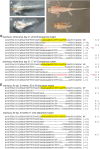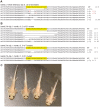Highly efficient targeted mutagenesis in axolotl using Cas9 RNA-guided nuclease
- PMID: 24764077
- PMCID: PMC4011087
- DOI: 10.1242/dev.105072
Highly efficient targeted mutagenesis in axolotl using Cas9 RNA-guided nuclease
Abstract
Among tetrapods, only urodele salamanders, such as the axolotl Ambystoma mexicanum, can completely regenerate limbs as adults. The mystery of why salamanders, but not other animals, possess this ability has for generations captivated scientists seeking to induce this phenomenon in other vertebrates. Although many recent advances in molecular biology have allowed limb regeneration and tissue repair in the axolotl to be investigated in increasing detail, the molecular toolkit for the study of this process has been limited. Here, we report that the CRISPR-Cas9 RNA-guided nuclease system can efficiently create mutations at targeted sites within the axolotl genome. We identify individual animals treated with RNA-guided nucleases that have mutation frequencies close to 100% at targeted sites. We employ this technique to completely functionally ablate EGFP expression in transgenic animals and recapitulate developmental phenotypes produced by loss of the conserved gene brachyury. Thus, this advance allows a reverse genetic approach in the axolotl and will undoubtedly provide invaluable insight into the mechanisms of salamanders' unique regenerative ability.
Keywords: Axolotl; CRISPR; Mutagenesis; Regeneration.
Figures



Similar articles
-
Generating and identifying axolotls with targeted mutations using Cas9 RNA-guided nuclease.Methods Mol Biol. 2015;1290:279-95. doi: 10.1007/978-1-4939-2495-0_22. Methods Mol Biol. 2015. PMID: 25740494
-
Application and optimization of CRISPR-Cas9-mediated genome engineering in axolotl (Ambystoma mexicanum).Nat Protoc. 2018 Dec;13(12):2908-2943. doi: 10.1038/s41596-018-0071-0. Nat Protoc. 2018. PMID: 30429597
-
Multiplex CRISPR/Cas screen in regenerating haploid limbs of chimeric Axolotls.Elife. 2020 Jan 28;9:e48511. doi: 10.7554/eLife.48511. Elife. 2020. PMID: 31989926 Free PMC article.
-
Advances in Decoding Axolotl Limb Regeneration.Trends Genet. 2017 Aug;33(8):553-565. doi: 10.1016/j.tig.2017.05.006. Epub 2017 Jun 22. Trends Genet. 2017. PMID: 28648452 Free PMC article. Review.
-
Exploring the role of microRNAs in axolotl regeneration.J Cell Physiol. 2021 Feb;236(2):839-850. doi: 10.1002/jcp.29920. Epub 2020 Jul 7. J Cell Physiol. 2021. PMID: 32638401 Review.
Cited by
-
Efficient Gene Disruption via Base Editing Induced Stop in Newt Pleurodeles waltl.Genes (Basel). 2019 Oct 23;10(11):837. doi: 10.3390/genes10110837. Genes (Basel). 2019. PMID: 31652881 Free PMC article.
-
CRISPR/Cas System and Factors Affecting Its Precision and Efficiency.Front Cell Dev Biol. 2021 Nov 24;9:761709. doi: 10.3389/fcell.2021.761709. eCollection 2021. Front Cell Dev Biol. 2021. PMID: 34901007 Free PMC article. Review.
-
Establishing an Efficient Electroporation-Based Method to Manipulate Target Gene Expression in the Axolotl Brain.Cell Transplant. 2023 Jan-Dec;32:9636897231200059. doi: 10.1177/09636897231200059. Cell Transplant. 2023. PMID: 37724837 Free PMC article.
-
Insights into regeneration tool box: An animal model approach.Dev Biol. 2019 Sep 15;453(2):111-129. doi: 10.1016/j.ydbio.2019.04.006. Epub 2019 Apr 13. Dev Biol. 2019. PMID: 30986388 Free PMC article. Review.
-
CRISPR-mediated genomic deletion of Sox2 in the axolotl shows a requirement in spinal cord neural stem cell amplification during tail regeneration.Stem Cell Reports. 2014 Sep 9;3(3):444-59. doi: 10.1016/j.stemcr.2014.06.018. Epub 2014 Aug 7. Stem Cell Reports. 2014. PMID: 25241743 Free PMC article.
References
Publication types
MeSH terms
Substances
Grants and funding
LinkOut - more resources
Full Text Sources
Other Literature Sources

